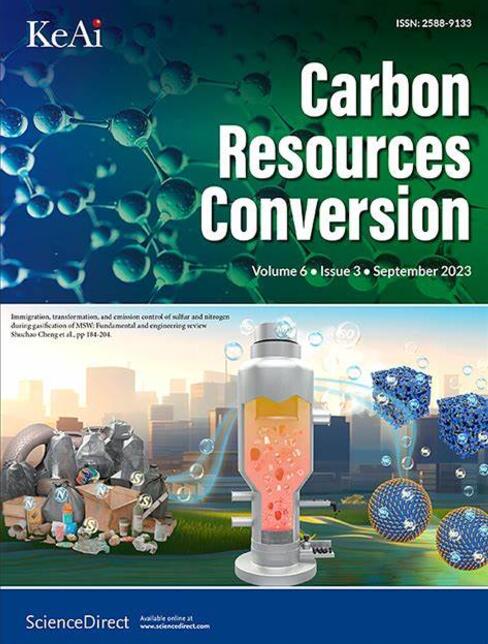Enhanced performance of gasification by blending coal into biomass in a fluidized bed two-stage system
IF 7.5
3区 环境科学与生态学
Q2 ENERGY & FUELS
引用次数: 0
Abstract
Biomass, blended with a small amount of coal, was fed into a fluidized bed two-stage gasifier to produce low-tar H2-rich gas through O2-rich gasification. The blended coal improved the energy density of biomass fuel and also worked as the bed material. For the fluidized bed two-stage gasification, large char particles of biomass and coal tend to accumulate at the bottom of the gasifier (a riser) to form a carbon-rich reaction zone there. Then, the O2 coming from the bottom of the gasifier mainly reacts with such char, consequently suppressing its interaction with the gases including H2 from pyrolyzer. Using O2-rich air with an ER of 0.35 and at gasification temperatures of about 890 °C, gasifying biomass blending 10 wt% coal produced gas containing 13.3 vol% CO, 20.1 vol% CO2, 4.3 vol% CH4, and 9.8 vol% H2, giving an LHV of 4.9 MJ/Nm3d. Tar content in the produced gas gradually decreased with time, and over the last 6 h the measured content was 0.012 g/Nm3d. Steady operation was well achieved, showing the performance without ash agglomeration for the O2-rich gasification of biomass.
在流化床两级系统中混合煤与生物质提高气化性能
将生物质与少量煤混合,送入流化床两段气化炉,通过富o2气化生产低焦油富h2气。混合煤提高了生物质燃料的能量密度,也可作为床料。对于流化床两段气化,生物质和煤的大炭颗粒倾向于积聚在气化炉底部(提升管),在那里形成富碳反应区。然后,来自气化炉底部的O2主要与这种焦炭反应,从而抑制其与热解器产生的H2等气体的相互作用。使用ER为0.35的富o2空气,在890°C的气化温度下,气化生物质混合10 wt%煤产生的含有13.3 vol% CO, 20.1 vol% CO2, 4.3 vol% CH4和9.8 vol% H2的气体,LHV为4.9 MJ/Nm3d。采出气中焦油含量随时间逐渐降低,最后6 h测得含量为0.012 g/Nm3d。稳定运行效果良好,显示了富氧生物质气化无灰结块的性能。
本文章由计算机程序翻译,如有差异,请以英文原文为准。
求助全文
约1分钟内获得全文
求助全文
来源期刊

Carbon Resources Conversion
Materials Science-Materials Science (miscellaneous)
CiteScore
9.90
自引率
11.70%
发文量
36
审稿时长
10 weeks
期刊介绍:
Carbon Resources Conversion (CRC) publishes fundamental studies and industrial developments regarding relevant technologies aiming for the clean, efficient, value-added, and low-carbon utilization of carbon-containing resources as fuel for energy and as feedstock for materials or chemicals from, for example, fossil fuels, biomass, syngas, CO2, hydrocarbons, and organic wastes via physical, thermal, chemical, biological, and other technical methods. CRC also publishes scientific and engineering studies on resource characterization and pretreatment, carbon material innovation and production, clean technologies related to carbon resource conversion and utilization, and various process-supporting technologies, including on-line or off-line measurement and monitoring, modeling, simulations focused on safe and efficient process operation and control, and process and equipment optimization.
 求助内容:
求助内容: 应助结果提醒方式:
应助结果提醒方式:


